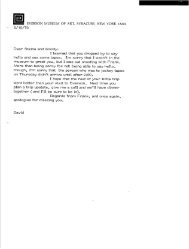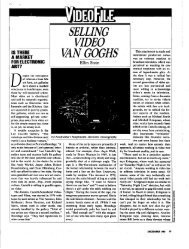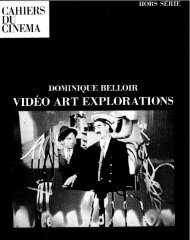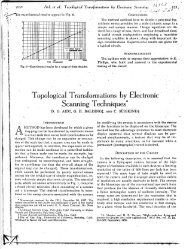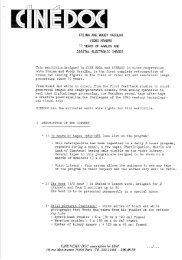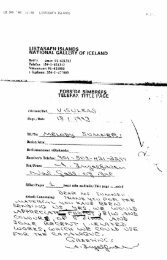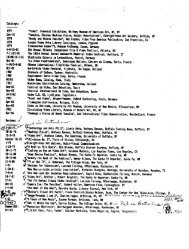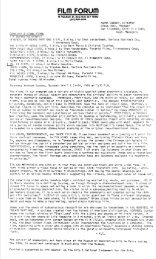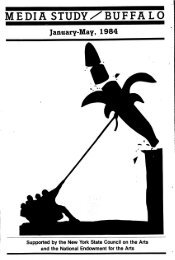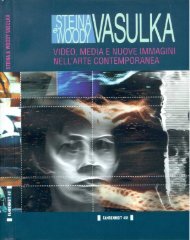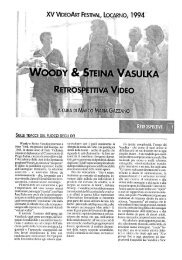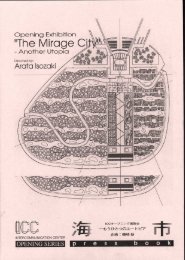ELECTRONIC ARTS INTERMIX VIDEOTAPES - Vasulka.org
ELECTRONIC ARTS INTERMIX VIDEOTAPES - Vasulka.org
ELECTRONIC ARTS INTERMIX VIDEOTAPES - Vasulka.org
Create successful ePaper yourself
Turn your PDF publications into a flip-book with our unique Google optimized e-Paper software.
Dear Friend :<br />
As we reviewed the tapes we have distributed over the last ten years while preparing this new<br />
catalogue, I began to appreciate what a treasure-house of programming we have accumulated in the<br />
room where the Master Tapes are stored . Ten years may be just a drop in the bucket of Universal Time,<br />
but it covers the life span of video . The first video exhibition anywhere was Nam June Paik's show in<br />
Germany in 1963, "Exposition of Music-Electronic Television ." However, it was not until Sony<br />
introduced its lightweight, low-cost "portable television" in 1967-68 that individual artist/ producers<br />
perceived that they could gain access to the television medium . This marked the birth of Video as we<br />
think of it today .<br />
EAI's involvement in Video goes backto the days of the Howard Wise Gallery in New York, which since<br />
1964 specialized in kinetic and electronic art. I included video works by Nam June Palk in the<br />
exhibitions "Lights in Orbit" (Feb . 1967) and "Festival of Lights" (Dec. 1967) . Then, after researching<br />
"the state of the art," I mounted the first survey exhibition of video, "TV as a Creative Medium" (May-<br />
June 1969) .<br />
I was so fascinated by the potentials of video as an art medium that I decided to concentrate my<br />
energies on the exploration of these possibilities, and early in 1971 I closed my Gallery and formed<br />
Electronic Arts Intermix, Inc. a s a not-for-profit corporation "to explore video as a means of personal<br />
expression and communication ."<br />
In this catalogue you will find over 225 carefully selected programs. Some were included in our 1973<br />
catalogue . Others were added from time to time because they were particularly appropriate to our<br />
distribution . You will find works by artists who are new to our listings. Some are well-established as<br />
video artists, while others are relatively new to the field, but all are producing video works of great<br />
distinction .<br />
One major contribution to television is rarely appreciated, and that is the development by video artists<br />
of a number of electronic devices (hardware) in their efforts to make the medium more amenable to<br />
their expression . Since 1969 a number of colorizers, video synthesizers, imagers and other special<br />
effects generators first devised by video artists, some working alone and others in collaboration with<br />
electronic technicians, have changed the look of television .<br />
You will find many of these artist innovators represented in the EAI collection . Examples are Eric<br />
Siegel, Nam June Paik, Dan Sandin, Woody <strong>Vasulka</strong> and Bill Etra. Techniques developed by these rare<br />
individuals have since been used by network television and advertising agencies, demonstrating their<br />
importance to the field, and proving that Picasso had a good point when he said "the followers make<br />
the leaders ."<br />
We will be more than pleased to welcome you at our headquarters and to screen works for you from<br />
our collection . You may also see our sophisticated 3/4-inch Editing/ Post Production Facility which<br />
accommodates about 300 individual artist/producers a year .<br />
We look forward to the pleasure of seeing you . Just phone us (212) 989-2316 so we may reserve the<br />
Viewing Room for you .<br />
Howard Wise<br />
President



